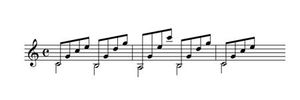Who would of thought that voice-leading is present in a piece like Study No. 1 from Carcassi's Twenty-Five Melodious and Progressive Studies, Op. 60? After all, isn't it just a bunch of scales and arpeggios? That is what I thought going into this analysis and was surprised to find an underlying linear structure that holds this piece together. Open the pdf below and we will get right to it.
Notice how the first note of the descending scales (after the bass note) in the opening three measures outlines the tonic arpeggio C-E-G (dotted slurs in reduction staff). Bar four is V/V preceding the next (dominant) arpeggio in measures five through eight (G-B-D) before the return to the C in measure nine.
So far Carcassi has laid out the tonic and dominant arpeggios with intervening scale passages. Now the most interesting linear motion begins in measure nine.
Beginning with the C in the upper voice in measure ten, trace the descending and ascending lines shown in the reduction staff.
MM. 10-14
Upper voice C moves step-wise down to A introducing relative minor key of A minor by way of its dominant (E7) in measure eleven.
MM. 14-17
Upper voice A returns to C as well as returning to the home key of C major with the G7 harmony implied in measure fifteen and sixteen. I consider the F# a chromatic lower-neighbor to the G as the F-natural sounds at the end of measure sixteen giving us the true dominant (G7) harmony.
MM. 17-21
Upper voice ascends to E introducing key of E minor (iii) conclusively with the B7 chord in measure twenty resolving to E minor in measure twenty-one.
MM. 21-27
Upper voice first ascends to F-natural in measure twenty-two (G7) before descending to A in measure twenty-five through the descending sequential line and linear intervallic pattern 3-5-3-5-3 shown. This is the first and only occurrence of the subdominant (measure twenty-five) in the entire piece.
We then ascend back to D in measure twenty-six and twenty-seven (ii-V) before returning to tonic (C) in measure twenty-nine.
The next five measures are problematic in terms of the voice-leading. We can see that Carcassi connects the triads G to C to G in measures twenty-nine and thirty (as well as in measure thirty-three) moving all the voices in parallel motion, as he outlines the tonic C major arpeggio shown with dotted slurs. This results in parallel fifths and octaves as shown, which was verboten. He could have corrected this easily if he had written mm. 29-31 like this for example:

The only reason for this that I can figure is he possibly ignored proper voice-leading in favor of working on the technical issue of shifting smoothly. It's not like he didn't know what he was doing and as if to prove it, writes perfectly fine voice-leading in the following four bars (mm. 34-37). This is one thing that distinguishes Carcassi from Fernando Sor. Sor would never sacrifice voice-leading for technical reasons. The music always came first with Sor.
Once again I have found structures that went completely unnoticed in a piece I have played for decades. I guess that doesn't say much for my power of intuition.
